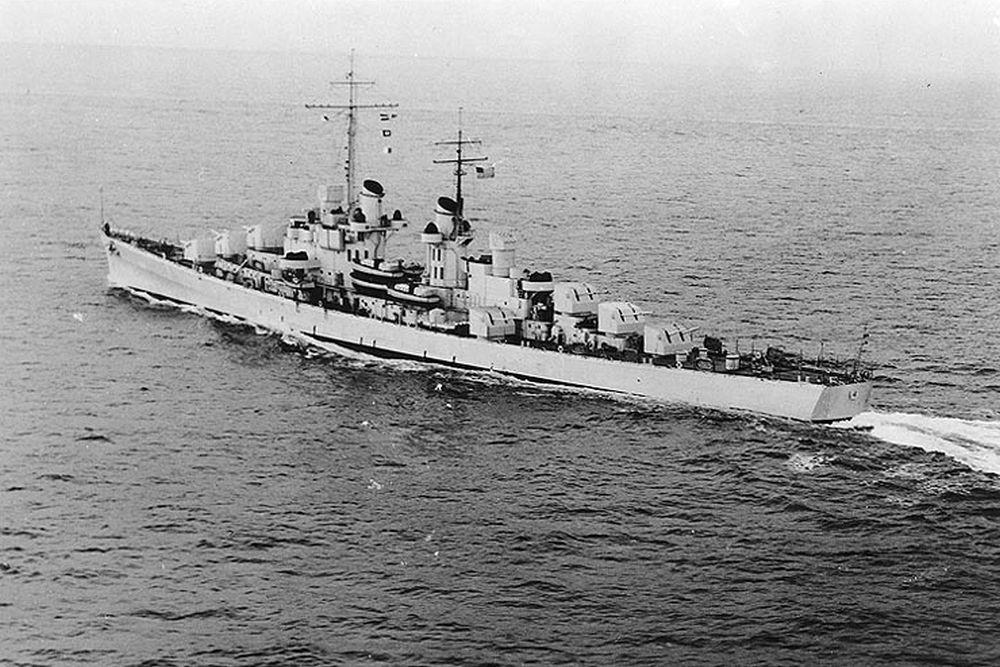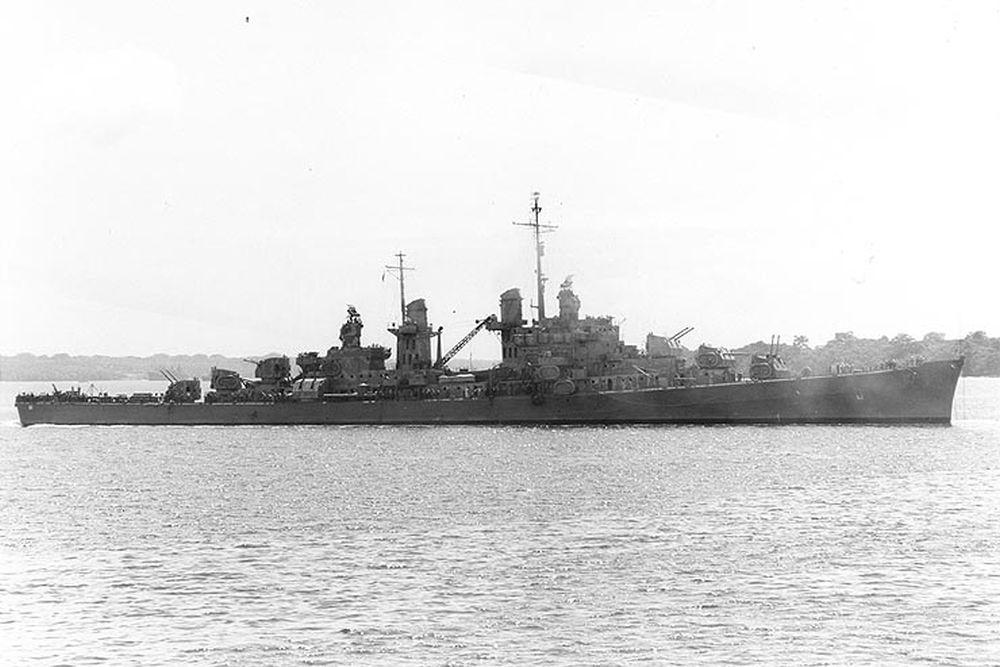Introduction
The USS Atlanta (CL-51) was the namesake of the Atlanta class of light cruisers and commissioned at the end of 1941. From April 1942 onwards, the ship was deployed in the Pacific operating out of Pearl Harbor. On November 13, 1942, the USS Atlanta sank after having been seriously damaged during the Battle of Guadalcanal.
Facts
| Built by: |
Keel laid: |
Launched: |
Commissioned: |
Fate: |
| Federal Shipbuilding and Drydock
Company, Kearny, New Jersey |
April 22nd, 1940 |
September 6th, 1941 |
December 24th, 1941 |
November 13th, 1942 (sunk) |
| Hull nr.: 168 |
||||
| Stationing: |
Date in: |
Date out: |
||
| December 24th, 1941 |
May 1942 |
Light cruiser USS
Atlanta (CL-51) US Navy |
||
| May 16th, 1942 | July 1942 | Task Force 16 (TF-16) | ||
| July 1942 | September 1942 | Task Force 61 (TF-61) | ||
| September 19th, 1942 | September 23rd, 1942 | Task Group 66.4 (TG-66.4) | ||
| September 23rd, 1942 | Task Force 17 (TF-17) | |||
| October 1942 | October 28th, 1942 | Task Force 64 (TF-64) | ||
| October 28th, 1942 | November 13th, 1942 | flagship Task Group 64.2 (TG-64.2) | ||
| January 13th, 1943 | stricken from the Naval Register | |||
Definitielijst
- cruiser
- A fast warship with 8,000 – 15,000 ton displacement, capable to perform multiple tasks such as reconnaissance, anti-aircraft defence and convoy protection.
History
The USS Atlanta (CL-51) was the namesake and the first of the Atlanta class (1941) light cruisers. Originally conceived to operate as a scout cruiser, the ships of this class could perform as a destroyer leader of a flotilla of destroyers as well. However, due to their armament, the ships mainly earned their reputation as anti-aircraft cruisers.
The keel for the USS Atlanta was laid down on April 22nd, 1940, at the Federal Shipbuilding and Drydock Co. in Kearny, New Jersey, as hull nr. 168. The ship was launched on September 6th, 1941. After her completion, the USS Atlanta was commissioned at the New York Navy Yard on December 24th, 1941, Captain Samuel P. Jenkins in command.[1]
Her sea trials and crew training lasted until March 13th, 1942, after which the USS Atlanta returned to the New York Navy Yard for repairs and adjustments based on the ship's trial results. On March 31st, 1942 the ship departed via the Panama Canal for its voyage to Pearl Harbor, Hawaii, where the ship arrived on April 23rd, 1942.[2]
On May 3rd, the ship left for exercises. After these were completed on May 16th, the USS Atlanta joined Vice Admiral William F. Halsey's Task Force 16 (TF-16), as the latter returned to Pearl Harbor on May 26th, 1942. The ship sailed with TF 16 on May 28th, 1942, to an operation zone northeast of Midway where the enemy was expected. During the entire subsequent Battle of Midway, USS Atlanta remained with TF 16. After the battle, it was instructed to return to Pearl Harbor on June 11th, 1942 where it received a refit, including the installation of an SC radar.[3][4]
On July 15th, 1942, USS Atlanta sailed with TF 16 towards Tonga. After taking supplies, the ship was assigned to Task Force 61 (TF-61) for the invasion of Guadalcanal. The ship remained with TF-61 even when it was withdrawn towards the Solomon Islands on August 9th.[5]
During her presence in the Solomon Islands, USS Atlanta took part in the battle around the Eastern Solomon Islands in August 1942. The light cruiser provided anti-aircraft support to USS Enterprise (CV-6). On August 30th, the Atlanta was assigned to Task Force 11 (TF-11), which itself was immediately redesignated to Task Force 61 (TF-61). From September 19th, 1942, she was part of Task Group 66.4 (TG-66.4) and from September 23rd of Task Force 17 (TF-17).
As part of TF 64, USS Atlanta participated in the Battle of the Santa Cruz Islands on October 26th, 1942. On October 28th, the ship became flagship of Task Group 64.2 (TG-64.2) and arrived on October 31st, at Esperitu Santo. On November 12th, while on escort duty off Guadalcanal, it was attacked by Japanese dive bombers at 09.20 hrs. These attacks were repelled. In the hours that followed, several other attacks were carried out by Japanese bombers. An approaching enemy fleet was reported, consisting of two battleships, a cruiser and six destroyers. Task Group 67.4 was assigned to cover the retreat of Task Group 67.1 against this oncoming fleet. During the night, firing contact was made with the Japanese ships and USS Atlanta targeted the Japanese destroyer Akatsuki. After other Japanese destroyers joined the battle, USS Atlanta was hit in her forward engine room by a torpedo, probably fired from either the Inazuma or the Ikazuchi, and USS Atlanta had to withdraw temporarily. The Japanese destroyer Akatsuki was less fortunate and sank. USS Atlanta was subsequently fired upon by USS San Francisco (CA-38), which mistook her for a Japanese ship. Only the superstructure of USS Atlanta was slightly damaged. However, Japanese fire had caused greater damage and the ship listed slightly.
At 09.30 hrs on November 13th, 1942, USS Bobolink (AT-131) arrived to take USS Atlanta under tow. However, the ship took on more and more water and after consultation with his superiors, Captain Samuel P. Jenkins decided to sink the USS Atlanta with a demolition charge. At 20.15 hrs, after all remaining crew members had abandoned ship, USS Atlanta sank 3 miles west of Lunga Point in approximately 400 feet of water. On January 13th, 1943, the USS Atlanta (CL-51) was struck from the Naval Vessel Register.[6]
In 1992, an expedition led by Dr. Robert Ballard discovered the wreck of the USS Atlanta. Further investigation was not possible due to the bad weather. In the following years, various divers made trips to the ship and in May 2011 video images of the wreck were made.
Definitielijst
- cruiser
- A fast warship with 8,000 – 15,000 ton displacement, capable to perform multiple tasks such as reconnaissance, anti-aircraft defence and convoy protection.
- destroyer
- Very light, fast and agile warship, intended to destroy large enemy ships by surprise attack and eliminating them by using torpedoes.
- invasion
- Armed incursion.
- Midway
- Island in the Pacific where from 4 to 6 June 1942 a battle was fought between Japan and the United States. The battle of Midway was a turning point in the war in the Pacific resulting in a heavy defeat for the Japanese.
- radar
- English abbreviation meaning: Radio Detection And Ranging. System to detect the presence, distance, speed and direction of an object, such as ships and airplanes, using electromagnetic waves.
- torpedo
- A weapon of war. A cigar shaped body fitted with explosives and a propulsion and control mechanism. Intended to target after launch a nearby enemy ship and disable it by underwater explosion.
Technical data
| Name: | USS Atlanta |
| Callsign/Registration: |
? / CL-51 |
| Builder: |
Federal Shipbuilding and Drydock
Company, Kearny, New Jersey |
| Hull number: |
168 |
| Type/Class: |
Light cruiser / Atlanta class (1941) |
| Displacement: |
6,718 long tons (standard)
8,340 long tons (fully loaded) |
| Length: |
164.94 meter |
| Beam: |
16.10 meter |
| Draft: |
6.25 meter |
| Installed power and propulsion: |
75,000 shp (56,000 kW)
2 geared turbines 4 boilers 2 propeller shafts |
| Speed: |
33.6 knots (61.11 km/h) |
| Maximum range: |
15,700 km (bij 15 knopen) |
| Armament: |
8 x 2 5-inch (127mm)/38 caliber guns
4 x 4 1.1-inch (28mm)/75 caliber anti-aircraft guns 8 x 20mm/70 caliber anti-aircraft guns 8 x 21-inch (533mm) torpedo tubes (in 2 quad launchers) |
| Complement: |
673 |
Definitielijst
- caliber
- The inner diameter of the barrel of a gun, measured at the muzzle. The length of the barrel is often indicated by the number of calibers. This means the barrel of the 15/24 cannon is 24 by 15 cm long.
- cruiser
- A fast warship with 8,000 – 15,000 ton displacement, capable to perform multiple tasks such as reconnaissance, anti-aircraft defence and convoy protection.
- torpedo
- A weapon of war. A cigar shaped body fitted with explosives and a propulsion and control mechanism. Intended to target after launch a nearby enemy ship and disable it by underwater explosion.
Commanding Officer
| Captain Samuel Power
Jenkins |
December 24th, 1941 -
November 13th, 1942 |
Notes
- Atlanta III (CL-51) 1941-1943 / Dictionary of American Naval Fighting Ships (DANFS)
- Atlanta III (CL-51) 1941-1943 / Dictionary of American Naval Fighting Ships (DANFS)
- Atlanta III (CL-51) 1941-1943 / Dictionary of American Naval Fighting Ships (DANFS)
- Terzibaschitsch, 1988, pag. 133
- Atlanta III (CL-51) 1941-1943 / Dictionary of American Naval Fighting Ships (DANFS)
- Atlanta III (CL-51) 1941-1943 / Dictionary of American Naval Fighting Ships (DANFS)
Information
- Article by:
- Wilco Vermeer
- Article by:
- Simon van der Meulen
- Published on:
- 12-12-2024
- Feedback?
- Send it!





